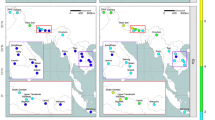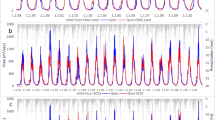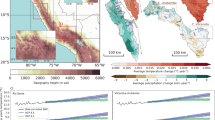Abstract
Rivers originating in the high mountains of Asia are among the most meltwater-dependent river systems on Earth, yet large human populations depend on their resources downstream1. Across High Asia’s river basins, there is large variation in the contribution of glacier and snow melt to total runoff2, which is poorly quantified. The lack of understanding of the hydrological regimes of High Asia’s rivers is one of the main sources of uncertainty in assessing the regional hydrological impacts of climate change3. Here we use a large-scale, high-resolution cryospheric–hydrological model to quantify the upstream hydrological regimes of the Indus, Ganges, Brahmaputra, Salween and Mekong rivers. Subsequently, we analyse the impacts of climate change on future water availability in these basins using the latest climate model ensemble. Despite large differences in runoff composition and regimes between basins and between tributaries within basins, we project an increase in runoff at least until 2050 caused primarily by an increase in precipitation in the upper Ganges, Brahmaputra, Salween and Mekong basins and from accelerated melt in the upper Indus Basin. These findings have immediate consequences for climate change policies where a transition towards coping with intra-annual shifts in water availability is desirable.
This is a preview of subscription content, access via your institution
Access options
Subscribe to this journal
Receive 12 print issues and online access
$209.00 per year
only $17.42 per issue
Buy this article
- Purchase on Springer Link
- Instant access to full article PDF
Prices may be subject to local taxes which are calculated during checkout




Similar content being viewed by others
References
Schaner, N., Voisin, N., Nijssen, B. & Lettenmaier, D. P. The contribution of glacier melt to streamflow. Environ. Res. Lett. 7, 034029 (2012).
Immerzeel, W. W. & Bierkens, M. F. P. Asia’s water balance. Nature Geosci. 5, 841–842 (2012).
Miller, J. D., Immerzeel, W. W. & Rees, G. Climate change impacts on glacier hydrology and river discharge in the Hindu Kush–Himalayas. A synthesis of the scientific basis. Mt. Res. Dev. 32, 461–467 (2012).
Galewsky, J. Rain shadow development during the growth of mountain ranges: An atmospheric dynamics perspective. J. Geophys. Res. 114, F01018 (2009).
Bookhagen, B. & Burbank, D. W. Towards a complete Himalayan hydrological budget: Spatiotemporal distribution of snowmelt and rainfall and their impact on river discharge. J. Geophys. Res. 115, 1–25 (2010).
Hewitt, K. Glacier change, concentration, and elevation effects in the Karakoram Himalaya, upper Indus Basin. Mt. Res. Dev. 31, 188–200 (2011).
Winiger, M., Gumpert, M. & Yamout, H. Karakorum-Hindukush-western Himalaya: Assessing high-altitude water resources. Hydrol. Process. 19, 2329–2338 (2005).
Hawkins, E. & Sutton, R. The potential to narrow uncertainty in projections of regional precipitation change. Clim. Dynam. 37, 407–418 (2010).
Bolch, T. et al. The state and fate of Himalayan Glaciers. Science 336, 310–314 (2012).
Radić, V. & Hock, R. Glaciers in the earth’s hydrological cycle: Assessments of glacier mass and runoff changes on global and regional scales. Surv. Geophys. 35, 813–837 (2014).
Frenierre, J. La & Mark, B. G. A review of methods for estimating the contribution of glacial meltwater to total watershed discharge. Prog. Phys. Geogr. 1–28 (2014).
Immerzeel, W. W., Pellicciotti, F. & Bierkens, M. F. P. Rising river flows throughout the twenty-first century in two Himalayan glacierized watersheds. Nature Geosci. 6, 1–4 (2013).
Archer, D. Contrasting hydrological regimes in the upper Indus Basin. J. Hydrol. 274, 198–210 (2003).
Siderius, C. et al. Snowmelt contributions to discharge of the Ganges. Sci. Total Environ. 468-469, S93–S101 (2013).
Kaser, G., Grosshauser, M. & Marzeion, B. Contribution potential of glaciers to water availability in different climate regimes. Proc. Natl Acad. Sci. USA 2010, 1–5 (2010).
Immerzeel, W. W., Van Beek, L. P. & Bierkens, M. F. P. Climate change will affect the Asian water towers. Science 328, 1382–5 (2010).
Sorg, A., Bolch, T., Stoffel, M., Solomina, O. & Beniston, M. Climate change impacts on glaciers and runoff in Tien Shan (Central Asia). Nature Clim. Change 2, 725–731 (2012).
Yao, T. et al. Different glacier status with atmospheric circulations in Tibetan Plateau and surroundings. Nature Clim. Change 2, 663–667 (2012).
Gardelle, J., Berthier, E., Arnaud, Y. & Kääb, A. Region-wide glacier mass balances over the Pamir-Karakoram-Himalaya during 1999–2011. Cryosphere 7, 1263–1286 (2013).
Lutz, A. F., Immerzeel, W. W., Gobiet, A., Pellicciotti, F. & Bierkens, M. F. P. Comparison of climate change signals in CMIP3 and CMIP5 multi-model ensembles and implications for Central Asian glaciers. Hydrol. Earth Syst. Sci. 17, 3661–3677 (2013).
Kääb, A., Berthier, E., Nuth, C., Gardelle, J. & Arnaud, Y. Contrasting patterns of early twenty-first-century glacier mass change in the Himalayas. Nature 488, 495–498 (2012).
Radić, V. et al. Regional and global projections of twenty-first century glacier mass changes in response to climate scenarios from global climate models. Clim. Dynam. 42, 37–58 (2013).
Arendt, A. et al. Randolph Glacier Inventory—A Dataset of Global Glacier Outlines: Version 3.2. Global Land Ice Measurements from Space (National Snow and Ice Data Center (NSIDC, 2012).
Keshavarzi, A., Sarmadian, F., Sadeghnejad, M. & Pezeshki, P. Developing pedotransfer functions for estimating some soil properties using artificial neural network and multivariate regression approaches. ProEnviron. 3, 322–330 (2010).
FAO/IIASA/ISRIC/ISSCAS/JRC. Harmonized World Soil Database (version 1.2) Food and Agriculture Organization of the United Nations, International Institute for Applied Systems Analysis, ISRIC-World Soil Information, Institute of Soil Science-Chinese Academy of Sciences, Joint Research Centre of the European Commission (2012).
Sheffield, J., Goteti, G. & Wood, E. F. Development of a 50-year high-resolution global dataset of meteorological forcings for land surface modeling. J. Clim. 19, 3088–3111 (2006).
Yatagai, A. et al. APHRODITE: Constructing a long-term daily gridded precipitation dataset for Asia based on a dense network of rain gauges. Bull. Am. Meteorol. Soc. 93, 1401–1415 (2012).
Kay, A. L., Davies, H. N., Bell, V. A. & Jones, R. G. Comparison of uncertainty sources for climate change impacts: Flood frequency in England. Climatic Change 92, 41–63 (2008).
Taylor, K. E., Stouffer, R. J. & Meehl, G. A. An Overview of CMIP5 and the experiment design. Bull. Am. Meteorol. Soc. 93, 485–498 (2012).
Acknowledgements
This study is a part of the Himalayan Climate Change Adaptation Programme (HICAP), which is funded by the Ministry of Foreign Affairs, Norway and Swedish International Development Agency (Sida). This work is partly financed through the research program VENI of the Netherlands Organization for Scientific Research (NWO). We acknowledge the World Climate Research Program’s Working Group on Coupled Modeling, which is responsible for CMIP5, and we thank the climate modelling groups for producing and making available their model output. We thank the Nepal Department of Hydrology and Meteorology, the International Water Management Institute Pakistan, the Pakistan Water and Power Development Authority and the Pakistan Meteorological Department for making available discharge data. Furthermore, we thank J. Sheffield for correcting errors in the Princeton Global Meteorological Forcing data set over the studied region and S. Bajracharya for overall support in the project.
Author information
Authors and Affiliations
Contributions
All authors contributed significantly to this work. The study was conceived by W.W.I., A.B.S. and A.F.L. A.F.L. and W.W.I. designed and implemented the cryospheric–hydrological model and conducted the analysis. A.F.L. prepared the manuscript. W.W.I., A.B.S. and M.F.P.B. contributed to the writing.
Corresponding author
Ethics declarations
Competing interests
The authors declare no competing financial interests.
Supplementary information
Rights and permissions
About this article
Cite this article
Lutz, A., Immerzeel, W., Shrestha, A. et al. Consistent increase in High Asia's runoff due to increasing glacier melt and precipitation. Nature Clim Change 4, 587–592 (2014). https://doi.org/10.1038/nclimate2237
Received:
Accepted:
Published:
Issue Date:
DOI: https://doi.org/10.1038/nclimate2237
This article is cited by
-
Water balance estimation and runoff simulation of Chameliya Watershed, Nepal
Environmental Earth Sciences (2024)
-
Integrated modeling for assessing climate change impacts on water resources and hydropower potential in the Himalayas
Theoretical and Applied Climatology (2024)
-
Runoff modelling and quantification of supraglacial debris impact on seasonal streamflow in the highly glacierized catchments of the western Karakoram in Upper Indus Basin, Pakistan
Environmental Earth Sciences (2024)
-
Inferring the impacts of climate extreme in the Kabul River Basin
Regional Environmental Change (2024)
-
Assessment of flood hazard along the N-S section of North Bengal plains, India
Natural Hazards (2024)



